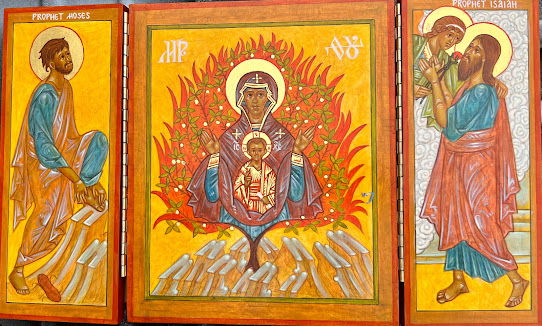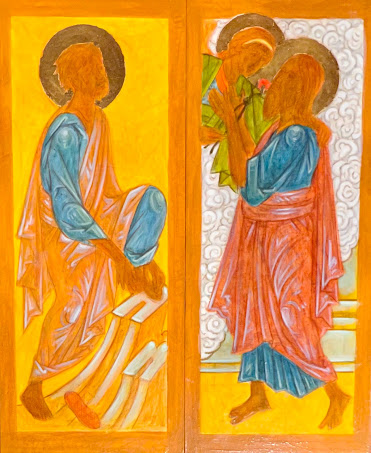Tuesday, December 27, 2022
The Light Shines in the Darkness and the Darkness Has Not Overcome It
Thursday, December 8, 2022
O Glorious Lady, Throned In Rest
'O glorious Lady, throned in rest, amid the starry host above, who offered nurture from your breast to God, with pure maternal love.'
This the first stanza of a hymn text by the 19th century English divine, John Mason Neale, an Anglican scholar and hymnographer and contemporary of Saint John Henry Newman. Like Newman, Neale was part of the Oxford movement and had a particular devotion to the Blessed Virgin Mary. Unlike Newman, in the end, Neale never undertook the ultimate step of becoming a Roman Catholic.
In Morning Prayer this morning for the Solemnity of the Immaculate Conception - a Marian dogma confirmed by another contemporary of Neale's, Pope Pius IX in 1854 - I came across this beautiful hymn to the Blessed Mother, entitled: "O Glorious Lady Throned in Rest" sung by Kathleen Lindquist in an album entitled : "Hymns and Chants of the Divine Office, Vol.1"
All of which coincides nicely with the Virgo Lactans or Nursing Mother of God icon* I've started working on as a way of meditating on the mystery of the Incarnation during Advent and Christmas. How Mary could give birth to God, much less nourish and nurture her Creator from her own body is a lot to reflect on, which I do better with a brush in my hand.
*In the Christian East icons of this type had the title of Galaktotrophousa in Greek and Mlekopitatelnitza in Slavonic.
Wednesday, November 2, 2022
Across the Finish Line
I completed the "Burning Bush Triptych" yesterday afternoon. The photo is a bit skewampus but the colors are pretty accurate.
I wish I could say that the last-minute decision to gild the fruit on the thorn bush was primarily motivated by theology, but actually, I realized that there needed to be something more in the background to balance the dominance of the gilding of the figures of the Mother of God and Jesus.
In other words, the gilding of the figures made the burning bush recede so much that it almost disappeared.
That said, I also realized that if I didn't balance out the figures in the foreground and the background, it would be distracting during prayer. (This icon is for the prayer corner in my studio, which means I'll be praying with it a lot).
Tuesday, October 18, 2022
Saint Luke, Pray for Us!
Today is the feast of St. Luke the Evangelist, the patron saint of artists and iconographers). I love this particular icon of him painting the icon of Mary, the Mother of God and Jesus, who are posing for him. The the composition of this icon is based on a drawing by my master teacher, Pere Igor. Unfortunately, I never had a chance to ask him why the pose of the two figures in the icon are so different from the actual figures who are standing in front of him. So on his feast I was able to make a bit more progress on highlighting the figure of the Mary and Jesus in the center of the triptych. Her garment is highlighted in paint; the figure of the Christ Child is highlighted with gold leaf (sometimes called 'gold assist').
His little overgarment is highlighted in much the same way as with paint, only using finer, sharper brush strokes. Instead of paint, gold size (a crushable compound called a mordant that dries tacky) is applied to all of the areas where a gold line is desired. It has to be thick enough so the brushstrokes will hold their shape and fluid enough to paint with.
When the size has set (depending on the size it will remain open for at least an hour or two), gold leaf is then pressed onto the areas painted with size. And voila! The gold lines appear as if by magic on the icon (usually) when the excess gold is gently brushed away with a soft brush.
Then follows the painstaking faulting of the gilded areas, because inevitably, their will be lines here and there that the gold did not adhere to or a line or two the one wielding the brush failed to paint in, and so the process is repeated once or twice (or again and again if you are having a particularly bad day) until all the gold lines are complete.
A couple of coats of shellac to fix the gold leaf (which is surprisingly fragile), followed by redrawing the lines as necessary to pull it all together.
Friday, October 14, 2022
Practice, Practice, Practice!
Thursday, October 13, 2022
In Praise of Pure Pigments
Tuesday, October 11, 2022
Ugly Duckling
Opening up the icon is the "ugly duckling" stage of the work of icon painting, as one begins laying in the base colors. Greenish-red faces, garish color contrasts, undefined forms etc... have to be put-up with at this point in the painting. A stage which must not be rushed through, even though the temptation is do exactly that.
Eventually (if all goes well), once the shadows, outlines, highlights, gold assist are added the ungainly gray cygnet will be transformed into a swan. But in the meantime....







